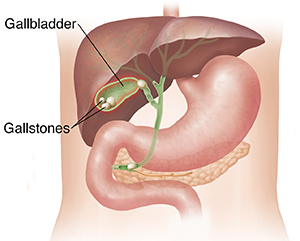Gallstones with Biliary Colic

Your abdominal pain is from irritation and spasm of the gallbladder. This is called biliary colic. The gallbladder is a small sac under the liver that stores and releases a bile. Bile is a fluid made in the liver that helps your body digest fat. Crystals may form stones inside the gallbladder (gallstones). Gallstones can cause the gallbladder to spasm. If they block the duct out of the gallbladder, they can cause pain and even an infection.
A number of things increase the risk of having gallstones:
-
Being female
-
Being severely overweight (obese)
-
Older age
-
Losing or gaining weight quickly
-
Eating a high-calorie diet
-
Being pregnant
-
Taking hormone therapy
-
Having diabetes
Home care
-
Rest in bed.
-
Drink only clear liquids until you feel better.
-
You may have been prescribed medicine for pain or nausea. Take these as directed.
-
Fat in your diet makes the gallbladder contract and may cause increased pain. Don't eat foods that are high in fat such as full-fat dairy, fried foods, and fatty meats for at least 2 days.
-
If you are overweight, talk with your healthcare provider about losing weight.
Follow-up care
Follow up with your healthcare provider or as advised. You may have another bout of pain from your gallstones at some point. Removal of the gallbladder is an option to prevent this. Talk with your healthcare provider about your treatment options.
When to seek medical advice
Call your healthcare provider if any of the following occur:
-
Pain gets worse or lasts for longer than 6 hours
-
Pain moves to the right lower belly
-
Repeated vomiting
-
Swollen belly
-
Fever of 100.4ºF (38ºC) or higher, or as directed by your healthcare provider
-
Very dark urine, light colored stools, or yellow color of the skin or eyes
-
Chest, arm, back, neck, or jaw pain
-
Symptoms get worse or you have new symptoms
Online Medical Reviewer:
Jen Lehrer MD
Online Medical Reviewer:
Marianne Fraser MSN RN
Online Medical Reviewer:
Raymond Kent Turley BSN MSN RN
Date Last Reviewed:
11/1/2021
© 2000-2024 The StayWell Company, LLC. All rights reserved. This information is not intended as a substitute for professional medical care. Always follow your healthcare professional's instructions.